1991 Topps Baseball Cards: A Classic Waiting to Happen
At the time of its release, more than a few viewed 1991 Topps Baseball as a dowdy, stuck-in-its ways, all-too-traditional release. For young fans of that time, Topps couldn’t compare to the vibrant and youthful Upper Deck, Leaf or even Topps brand-new offshoot, Stadium Club. Topps relied on a sales gimmick, tied to its anniversary, to entice collectors to the old standby, while still dressed in the familiar, old, gray cardboard. Nope, the Old Gray Mare ain’t what she used to be.
But upon 30 years of reflection, that gray-cardboard set marks the dividing line between the traditional baseball card sets issued the 40 years prior to 1991 and the bright, white and slick sets that have dominated the industry in the last three decades.
1991 Topps, still, is the last flagship set from the company to use gray, cardboard stock, a look and feel that has gone the way of paper rituals like penning thank you notes. To some veteran collectors, it remains the last “true” baseball card set and has been elevated in their minds through year a fter year of glossy fronts and backs.
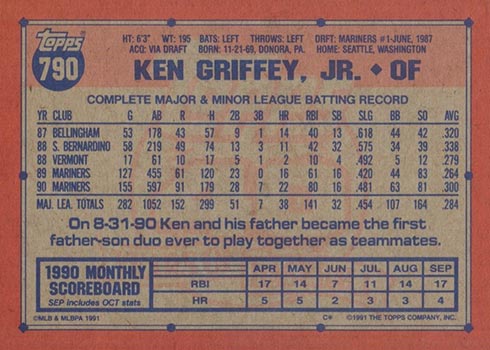
For this reason, and others, 1991 Topps Baseball is timeless, as it offers a number of attractions as varied as the hobbyists who are collecting the set still.
For Them:
- It’s that last cardboard set, tying son to father to grandfather. A card from 1991 looks and, more importantly, feels like a card from 1961.
- It’s that 40th Anniversary, as collectors from that year recall buying box a fter box of 1991 Topps, attempting to “Chase the Mick,” as the company advertised that it had inserted randomly one of every single card it had issued from 1952-91 into individual packs.
- It’s a different kind of chase that extends to present-day collecting as a seemingly endless number of errors and variations have captured the fascination of collectors across collecting blogs and chat rooms for decades.
- It’s the retro-appreciation for a set overlooked in its time. Once blinded by the bells and whistles of the new early ’90s premium sets, collectors returned to 1991 Topps to find some of the most dynamic and interesting photos in a flagship set.
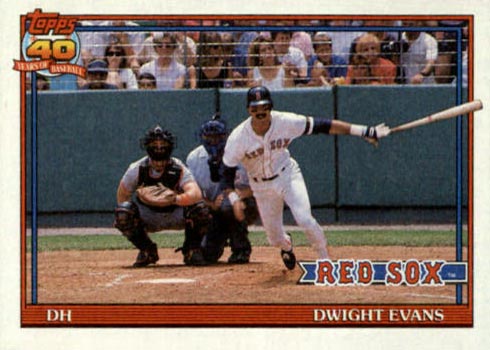
A separate treatment of each of these four attractions might help explain the continuing appeal of “The Last Gray Cardboard Set.”
1. It’s Not Easy Being Gray
Outside of Bowman, which was owned by Topps, the 1991 Topps flagship set stood alone as the only set issued that year on gray stock. The number of sets continued to expand that year and each one printed their pictures on lighter, whiter stock. Heck, even many minor league sets avoided gray cardboard.
The perception of the time was the king had lost its crown. As regal as 1991 Topps Baseball is in retrospect, why would kids collect something that looked like their father’s set when so many younger products were calling to them?
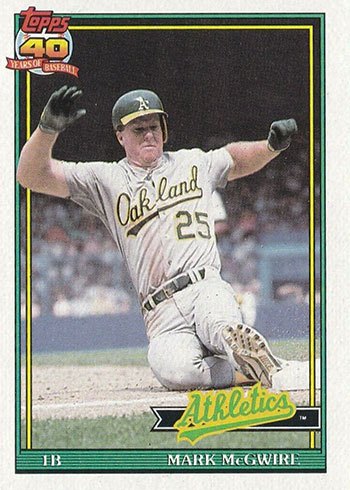
“Like so many kids of my generation, I was pretty hooked on cards by late 1990,” said Dylan Charles, a collector on the West Coast. “1991 Topps was, to be honest, nothing remarkable to my kid self while products like Upper Deck, Leaf and Stadium Club were demanding allowance dollars.”
Topps had also returned to a more reserved design to celebrate its anniversary one year after offering one of its flashiest flagship designs ever, the comic book-themed 1990 set. The ’91 look in comparison appeared staid and — here’s a word companies never want to hear when marketing to kids — boring.
But those kids are adults 30 years later and many now appreciate a clean design that may have been too subtle for younger collectors. The ’91 design offers an element never before seen on Topps cards, instead of merely listing the team name, it utilizes word marks for each club, mimicking the script on the uniform.
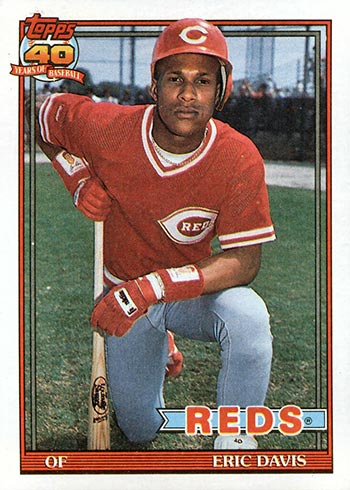
In the opposite corner, Topps trumpets its 40th Anniversary, a 792-card salute to its reign as the preeminent bubble gum card company in the world. A double border in two different colors houses the photo image, except when that image is breaking out of the design.
The combination of the low-profile design, the open presentation of the photos and traditional card stock has caused many collectors to come back to 1991 Topps Baseball with a new respect. For some of those veterans, 1991 Topps will always be the last “real” baseball card set. Those sets that followed just don’t seem like trading cards to them.
2. 1991 Topps Baseball: Part Collecting/Part Scavenger Hunt
Although the conventional look of 1991 Topps Baseball may have conveyed a feeling of self-satisfaction from the company, evidence that the competitive wheels were still turning could be found on every red wax pack issued.
“INSTANT WIN,” each pack proclaimed in the bottom right corner. “Vintage Topps Cards. Anniversary Sweepstakes. Win Complete Vintage Sets. 1952 to 1990. Total Prize Value. One Million Dollars,” the pack advertisement continued. No matter what form of packaging a collector purchased, the promotion appeared, exclaiming the chance to pull any card from Topps’ vast inventory from the previous 40 years.

Topps, in a furious battle with rivals Upper Deck and others in a card market that had been booming over the previous five years, added to its promotion by advertising its instant-win game in television commercials.
“I think it’s a great promotion,” Richard O. Rieger, an analyst for a financial services company, told the Los Angeles Times in 1991. “It’s like they found old cards in a warehouse and held an auction.”
Indeed, Topps did unearth many of the old cards for the promotion in its Brooklyn headquarters but it also bought cards from fellow collectors for the contest. It then advertised the insertion of every single card, some 300,000 in total, from its 40-year archive into packs. Each wax and cello pack contained an Instant Win Game card that provided the opportunity for the collector to win a complete set from Topps’ past 40 years. Forty collectors who found an “X” on their Instant Win Game card won a complete set from a random year from 1952-90. Collectors could also enter the grand prize drawing by filling out the back of the game card for the opportunity to win every flagship set that Topps had created in the previous 40 years.
Topps took no prisoners in this aspect of its marketing campaign, relying on a vast inventory that no competitor could touch. In the end, Jack Glenn, a 43-year-old collector from New York City, won the grand prize of every Topps set.
But there were still all those randomly inserted cards. The promotion captured the imagination of collectors everywhere as they opened multiple boxes of 1991 Topps Baseball in a bid to “Chase the Mick” — the famed 1952 Topps Mickey Mantle card — and land the coveted card for “free,” or at least for the price of however many boxes were opened.
Many collectors reported opening countless containers without finding a single vintage card, not even a 1989 Topps common. Others reported pulling a lone ’70s checklist for their opening labor. What wasn’t known at the time was that only vintage cards valued at $50 or less were randomly inserted into packs. For cards worth more than that amount or issued prior to 1957, Topps inserted redemptions, according to the spokesman for Topps at the time.
“I really have no clue,” said Charles on how much ’91 Topps he’s opened over the years. “I used to have a running estimate but I couldn’t say at this point. I can safely say many, many cases worth of most packing types. Not to mention the hundreds of thousands of (opened product) cards found in hand-collated sets, collections, thrift store hauls and miscellaneous boxes that I have picked up over the years. And to date I’ve only pulled a single vintage card, a 1968 common!”
But Charles, and others, have opened that much ’91 Topps for another reason, one that continues to make the set as collectible as anything issued by Topps today.
3. ‘As Eccentric As It Gets’
Charles, the West Coast collector, created the blog “Junk Wax Gems” in 2009. The title is a reference to the irreverent nickname given the famous (infamous?) collecting period of 1986-93, a time in which trading card companies oversaturated the market with cards to meet the demand of an expanding consumer base.
The blog covers a number of sets from that period, even from other sports, but readers keep returning to the posts about 1991 Topps, and many are armed with questions:
* “I have a Carmelo Martinez (who) played for the Pirates (and) all the Pirates cards have a black border around them but Car-melo’s border is grey … is it (an) error.”
* “I have a Steve Olin #696 with a faded logo, and the E*F* print code.”
* “Is there a way of finding out all the errors that people have found (and) posting them on one post?”
Dylan’s answer to the last question was, “No, there is not. It requires a lot of work, especially if you want to collect the more nuanced and questionable varieties.”
One of the many hats that 1991 Topps Baseball wears is its reputation as one of the most variation-heavy sets ever created. The Trading Card Database website lists 81 different variations or errors for the set, from the more famous — such as Keith Comstock’s card (#337) appearing with either a Cubs or Mariners word mark on the front, or the Dodgers’ Jose Gonzalez (#279) appearing with team-mate Billy Bean’s image — to the more obscure sheet print code variations found in tiny letters on the back bottom right corner of each card.
This has a produced a legion of ’91 variation collectors who have been unearthing differences in the set for the past decade, years a fter it was issued.
“This set is especially interesting to me because a master set contains more variations than any other Topps set, before or since (excluding intentional parallels and variations),” Charles said. “The set also offers several tiers for variation or master set collectors. Whether you include the sequential game card inserts, the bold 40th logo cards, the “Glow Backs,” the sheet code variants or just the more clear-cut error and corrected cards; it can go pretty deep and that means a lot of mystery to explore. Much of it isn’t particularly expensive to acquire, which helps to retain the fun element of chasing something so encompassing.”
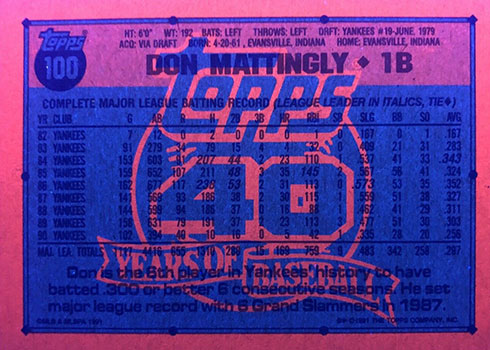
Among those collecting avenues referenced by Charles are the 40th Anniversary logos found underneath the player’s statistics on the back of the card. Most of the cards show the logo faded with the stats easy to read, while variations off er a bright, bold, red logo that dominates the stats.
Some of the logos and card backs glow when placed under a black light, demonstrating the resourcefulness and zeal of 1991 Topps collectors to find such an anomaly.
Among the more well-known and difficult variations to discover include the Doug Drabek card (a white inner border rather than a black one), the Dennis “Oil Can” Boyd card (hand under the flag on the Topps 40th anniversary logo) and the highly sought Mark Whiten card variation, in which Whiten’s hand gripping the bat handle overlaps the white outer edge of the card. Copies of the Whiten variation are currently going for $50-$80 ungraded.
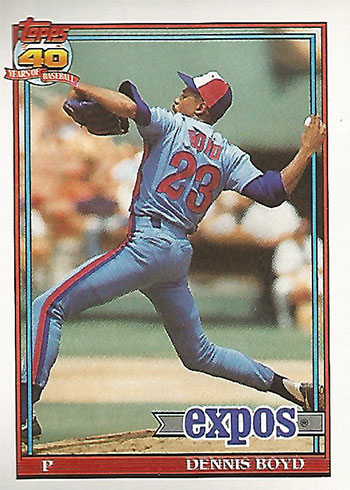
The wide variety of variations and the obscurity of many of them is the reason why Charles created his blog, to counter much of the incorrect information he has seen.
“Many of the rarer cards … sell for very little since they haven’t had the right publicity or the legitimization of an entry in the big guides,” he said. “This was a big motivating factor behind starting Junk Wax Gems. To pick up where the guides left off after the majority of the hobby moved on [past] error cards.”
Charles does not believe the many variations — which include several statistical errors — were intentional on Topps part, which has been a common accusation regarding the litany of errors found in a number of sets during the overproduction era. Instead, he attributes it to the volume of cards that Topps was producing that year, possible multiple print runs and creating them at more than one printing facility.
“I do believe that Topps upped the production on this set, being a big anniversary issue with a massive promotion behind it. With that likely came mistakes,” he said. “There are clearly two, distinct, packaging types for two different market destinations and with each, specific variations are found. … I think most were accidental and the result of Topps wanting to get things right as the presses continued.”
4. ‘Finally, a Superb Topps Baseball Card Set’
That was the headline topping an article written by John Leptich for the Chicago Tribune in October 1990, during the first viewings of the new 1991 Topps set.
While some collectors continued to dismiss Topps amid its latest release — Leptich also accused the company of putting out “inferior” products in prior years — others noticed what many collectors wouldn’t realize until years after the fact: 1991 Topps is a classic.
The variety of Topps photography in the set stands out to this day. For the first time since the 1974 Topps set, the company included individual player cards that were oriented horizontally. Capitalizing on improvement in photography, Topps unveiled powerful images, such as the action-packed Carlton Fisk (with big Cecil Fielder barreling toward home), Walt Weiss and Rickey Henderson cards, all with horizontal displays.
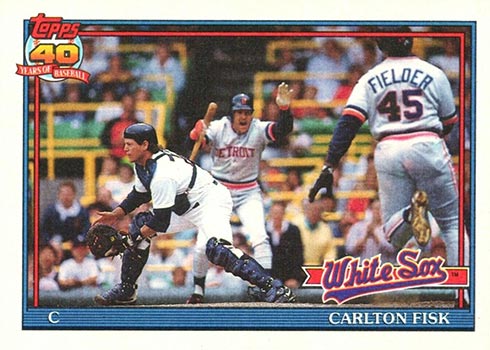
Topps also used the horizontal layout — a technique it still uses in flagship today — to produce striking portrait cards such as Roger Clemens propped up against the Fenway Park scoreboard. Other memorable portraits are packaged vertically, such as the overhead “Benny” Santiago shot and the striking “from-the-ground-up” Wade Boggs photo. Check out those clouds!
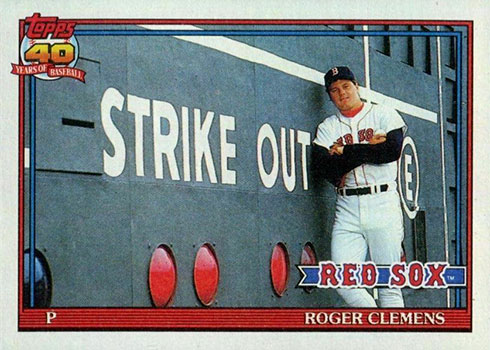
Whether it’s the wide-angle photo of Dwight Evans following through at the plate or Sandy Alomar Jr. chasing down a pop-up in full catcher’s gear, arms outstretched, 1991 Topps offers photographs that had never been seen before and in some cases never been seen since.
The multiple borders in the design allow multiple 3-D effects chosen seemingly at the whim of the Topps artists. Fred McGriff’s extended bat stays within the frame while Evans’ bat breaks all the way through.
Topps issued many spinoffs of its 1991 set, from the glossy Tiffany sets, to the Micro set, to the box-bottoms, rookie debut cards and the tough Desert Shield versions.
The popularity of 1991 Topps Baseball does not come from the Rookie Cards that continue to carry so many other sets — only the Chipper Jones draft pick retains significant rookie value — it resides in its variety, the stunning photography and the continued collectability of the set, the ability to be all things to all collectors.
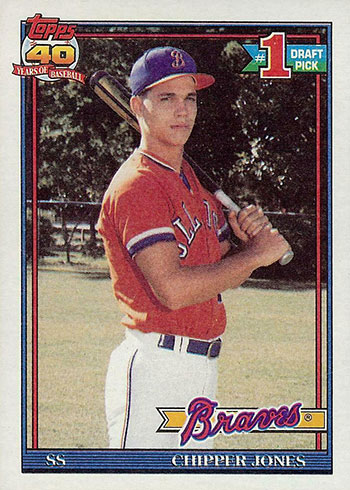
Yeah, 1991 Topps Baseball contained those old familiars – the record breaker cards, league leader cards and … ugh … checklists, each issued on gray cardboard for one last time.
But somehow, this relic of the past remains relevant, 30 years later.

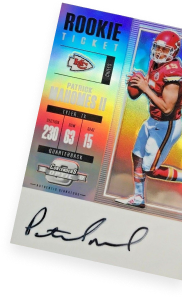






None here
I do not collect them.
I’m not collecting again till Topps bring back inexpensive cards like they did in the 1980’s.
I have a brand new box still wrapped up are they wourth anything
I got my dads card collection going back to the mid 1940’s. Not only the 3 main sports but there are WWII cards, celebrity cards (Yvonne DeCarlo), Hopalong Cassidy, etc. primarily baseball with complete sets for 1948-59. I began buying in 1967 and in 1972 I got lazy and just bought complete sets, that I did mail order not at the corner store. I have basketball sets from 1969(?)-78 including all ABA players and football from 1968-1981. I had them in their original boxes placed in shoeboxes in my closet, in fact in 2019 I offered the entire package to a friend in NY for $1000 plus shipping, fortunately his kid isn’t into sports so he said no. PFEW as I did sell every card to one guy who appreciates them and will take care of them, and yes, much more than $1000.
I own this 1991 box set
Don’t forget chipper jones rc with frank minefield football back. Super rare and up to $5k graded mint.
Ill give you 2000 !
I’m looking for the way to the honest price for a van load of NFL hockey baseball basketball collection.
I have lots of cards from baseball, hockey, basketball, and football.
does adding the contest cards to the collection increase it’s value?
If they do, by very little. But most collectors are probably focused on the main set.
I have about 200 cards baseball, my oldest son started collecting ,Dow to youngest,49 yrs ago , how do I find value
The price guide is linked in the top menu of this page.
I found about 100 packs of these 91 Topps 40th anniversary in my dad’s house after he passed. My brother and I must have gotten tired of opening them, and moved on to something new. Pretty neat find.
I have this box set too. The only box set I ever purchased. What a joy reading! I’m familiar with all the cards shown. What a joy it was to read.
I have those 1991 Topps cards how can I get them graded and sell fo.the best price
If you are looking for information on Beckett Grading, their website it beckett.com/grading.
I have most of them which is crazy I need help getting them graded I actually have the chipper Jones randy Johnson rookie cards an more all great condition
I have hundreds of cards from this 91 set in plastic holders in my basement. I was 13 when this came out and it was the last year I really went nuts buying cards. My years of habitual buying were 87-91. I started high school in 91 so by late summer I packed all the cards safely away and never checked them out. Thanks for this article… I have something to share with my 2 boys now. It will be blast checking the cards out now for favorites, rookies, errors and all the memories. Loved Beckett back then and I’m gonna check it out again.
I have a lot of these football cards late 70’s and up baseball basketball I’m wondering if the have any value
The price guide can be accessed in the top menu of this page.
I have 3 boxes of these
I have an actual 91 Topps unopened box set. Long red box 40th anniversary.
Anyone have any idea how much a unopened box of 4 decades of baseball cards worth
I have hundreds of these cards in good to perfect condition.
I was the winner of the 1959 complete set from mailing in the insert cards. They have remained in a safety deposit box since 1991. Any idea if they are all mint or could some have minor damage since cards were purchased back from collectors? Thanks!
@Sam – You would need to look at the cards to determine that.
I hve the whole collection of topps 40 baseball cards how do I find value
There’s a link to the price guide at the top of this page.
I have a load of these cards from 91 but who buys them anymore?
I have about 30 box or 1991 tops baseball cards.
I have some Topps baseball cards (1988-1991).How do I get the value of these cards?
There were only a handful of cards worth more that $50 during this time. And there are only a couple worth over $300-$10,000. I was lucky enough to find an original George Bush senior in his yale uniform. I haven’t had it graded yet, but I’m guessing it will be worth close to $10k if not a little more.
I have over 2000 91 baseball cards how do I know which ones are worth money ?
The price guide is linked in the top menu of this page.
I have cards from early 1900’s and up my son inherited them some are in books all in good shape . I don’t know what to do with them all .
I have a Chipper Jones rookie card mint not graded. What is the value of that card? I was told graded it’s 10k
Great article! I read it a while ago and because of it, finally picked up a factory sealed set for ~$20 tonight. Thank you for highlighting such a beauty!
Great article, I loved reading it. But it didn’t mention if anyone found the Mick. Since Topps put redemption cards in, they should know if it ever was redeemed, because I would love to hear stories from people who actually found good vintage cards in the packs.